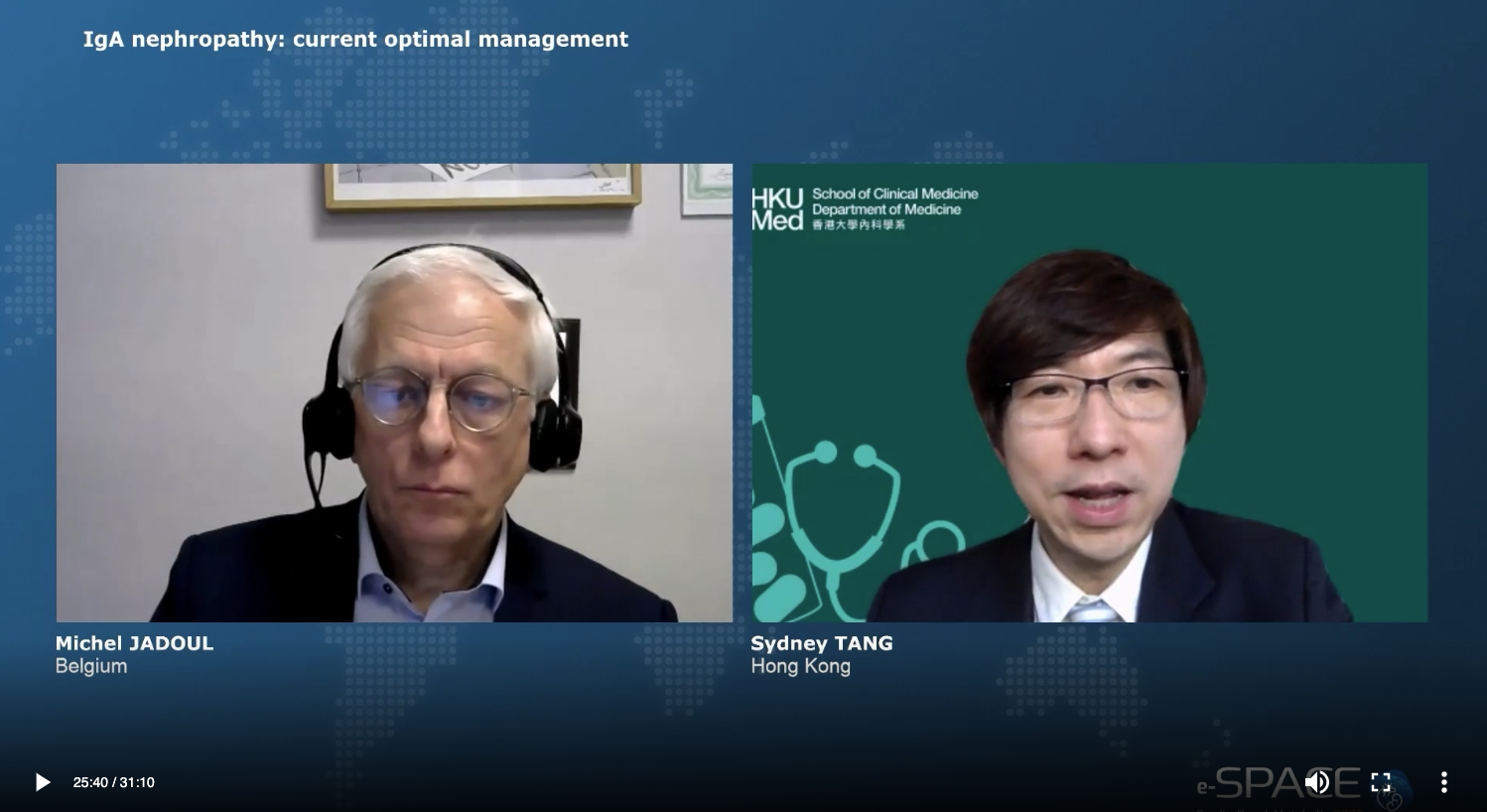e-SPACE Cardio-Renal-Metabolic 2022: On-demand
Published: 11 April 2022
-
Views:
 18559
18559
-
Likes:
 7
7
-
Views:
 18559
18559
-
Likes:
 7
7
-
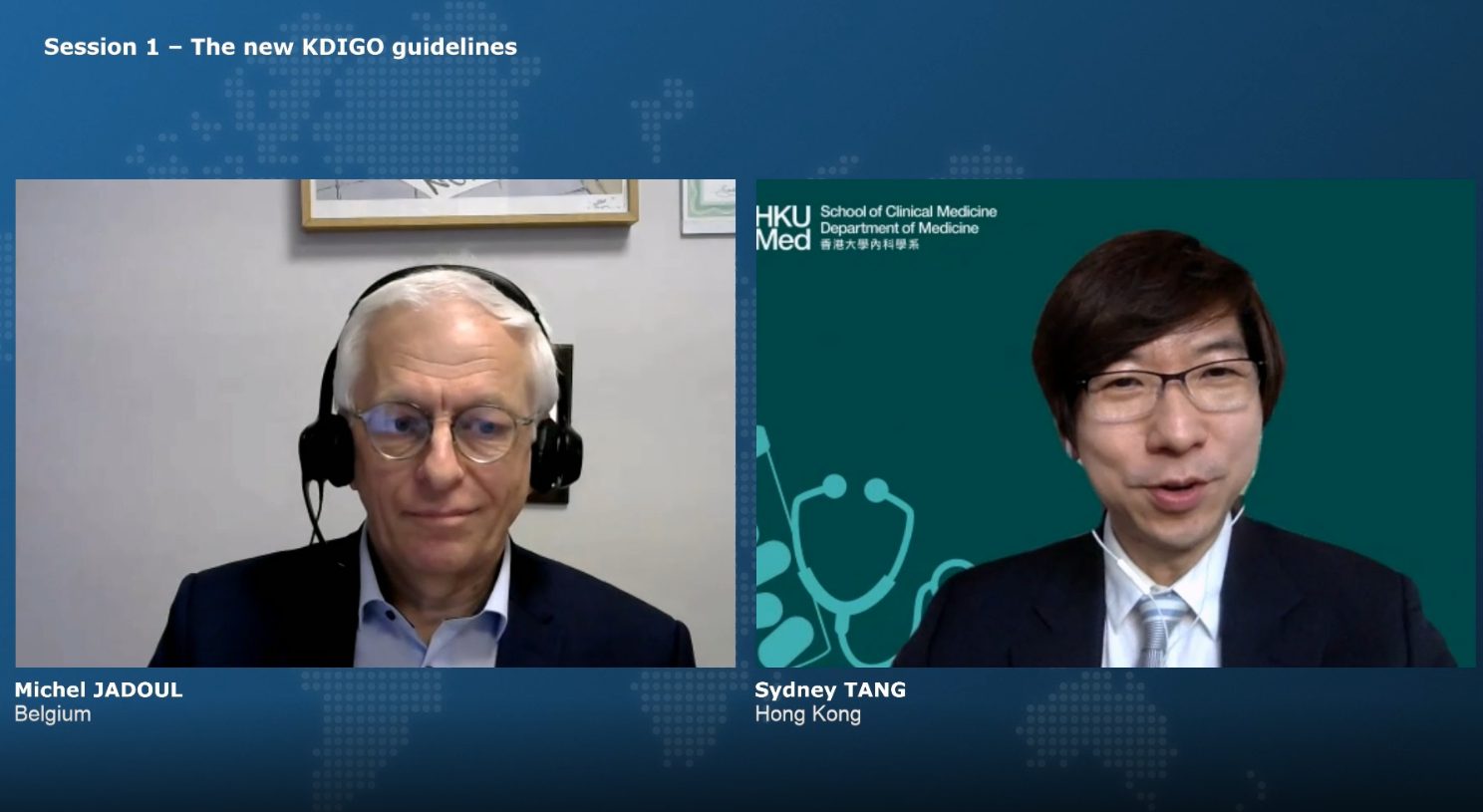 55sPart 2 | Session 1 Welcome and introduction
55sPart 2 | Session 1 Welcome and introduction -
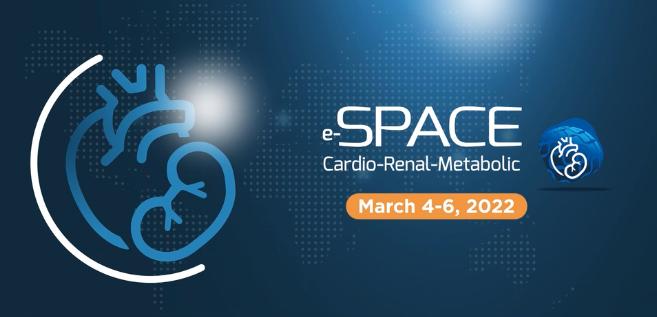 9m 28sPart 2 | Session 2 1.1: BP in CKD Guidelines
9m 28sPart 2 | Session 2 1.1: BP in CKD Guidelines -
 8m 48sPart 2 | Session 3 1.2: Diabetes and CKD GL
8m 48sPart 2 | Session 3 1.2: Diabetes and CKD GL -
 7m 30sPart 2 | Session 4 1.3: General management of the nephrotic syndrome
7m 30sPart 2 | Session 4 1.3: General management of the nephrotic syndrome -
 31m 57sPart 2 | Session 5 Panel Discussion
31m 57sPart 2 | Session 5 Panel Discussion
-
 1m 4sPart 3 | Session 1 Welcome and Introduction
1m 4sPart 3 | Session 1 Welcome and Introduction -
 8m 2sPart 3 | Session 2 Management of iron deficiency in heart failure: new evidence, new guidelines
8m 2sPart 3 | Session 2 Management of iron deficiency in heart failure: new evidence, new guidelines -
 10m 31sPart 3 | Session 3 Iron deficiency in chronic kidney disease: why iron matters beyond anaemia
10m 31sPart 3 | Session 3 Iron deficiency in chronic kidney disease: why iron matters beyond anaemia -
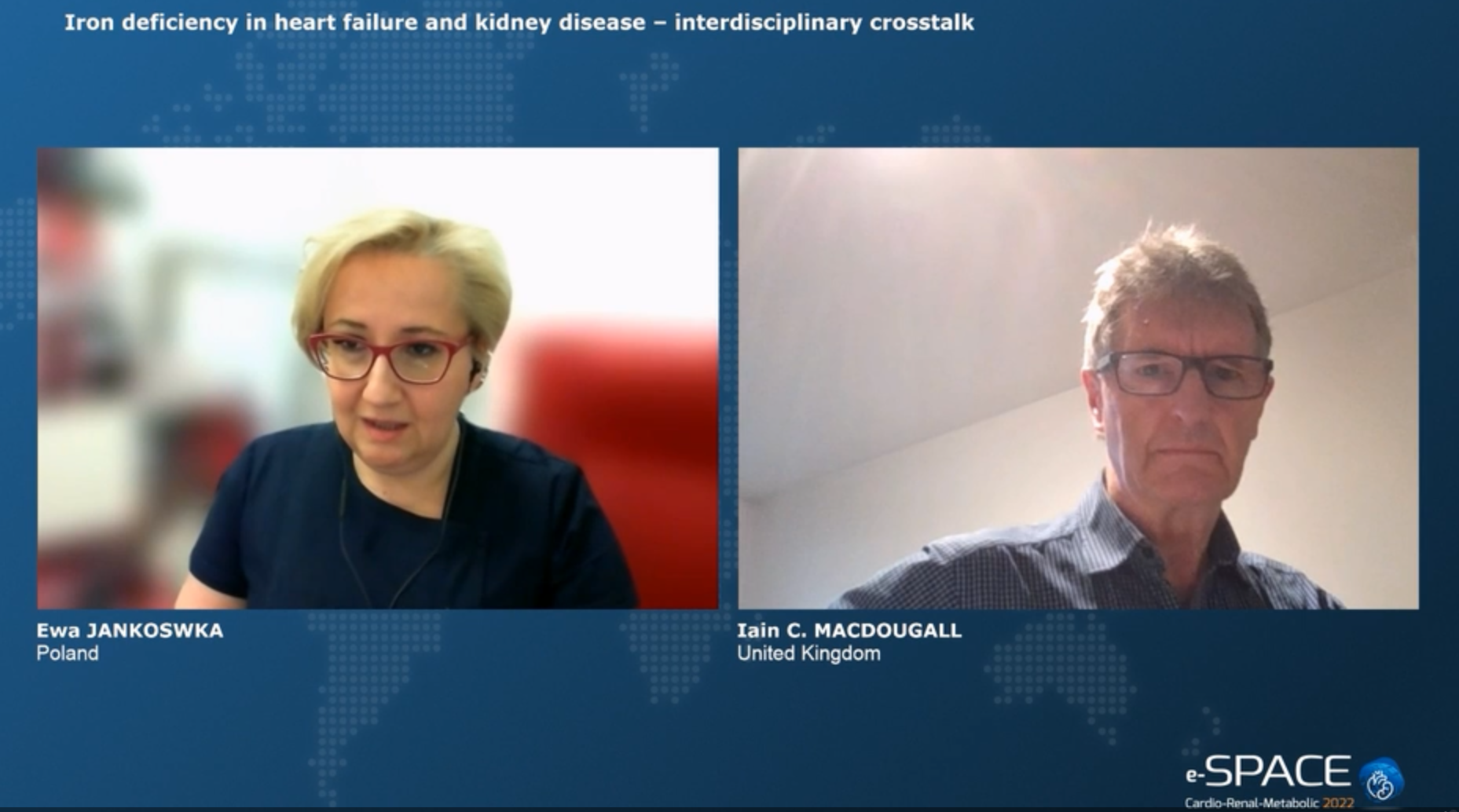 11m 28sPart 3 | Session 4 Interactive panel discussion
11m 28sPart 3 | Session 4 Interactive panel discussion
-
 1m 29sPart 4 | Session 1 Introduction
1m 29sPart 4 | Session 1 Introduction -
 16m 37sPart 4 | Session 2 2.1: The new ESC HF guidelines
16m 37sPart 4 | Session 2 2.1: The new ESC HF guidelines -
 8m 23sPart 4 | Session 3 2.2: Personalised management
8m 23sPart 4 | Session 3 2.2: Personalised management -
 9m 7sPart 4 | Session 4 2.3: Preventive cardiology
9m 7sPart 4 | Session 4 2.3: Preventive cardiology -
 25m 36sPart 4 | Session 5 Panel Discussion
25m 36sPart 4 | Session 5 Panel Discussion
-
 1m 9sPart 6 | Session 1 Introduction
1m 9sPart 6 | Session 1 Introduction -
 8m 4sPart 6 | Session 2 3.1: Focus on diabetology
8m 4sPart 6 | Session 2 3.1: Focus on diabetology -
 9m 10sPart 6 | Session 3 3.2: Focus on cardiology
9m 10sPart 6 | Session 3 3.2: Focus on cardiology -
 7m 30sPart 6 | Session 4 3.3: Focus on nephrology
7m 30sPart 6 | Session 4 3.3: Focus on nephrology -
 33m 58sPart 6 | Session 5 Panel Discussion
33m 58sPart 6 | Session 5 Panel Discussion
-
 1m 13sPart 7 | Session 1 Introduction
1m 13sPart 7 | Session 1 Introduction -
 7m 28sPart 7 | Session 2 The meaning of Hemoglobin A1C for the nephrologist
7m 28sPart 7 | Session 2 The meaning of Hemoglobin A1C for the nephrologist -
 8m 10sPart 7 | Session 3 The meaning of Hemoglobin A1C for the cardiologist
8m 10sPart 7 | Session 3 The meaning of Hemoglobin A1C for the cardiologist -
 14m 13sPart 7 | Session 4 Panel discussion
14m 13sPart 7 | Session 4 Panel discussion
-
 2m 6sPart 8 | Session 1 Introduction
2m 6sPart 8 | Session 1 Introduction -
 8m 15sPart 8 | Session 2 4.1: GLP-1RA and CVD in diabetes
8m 15sPart 8 | Session 2 4.1: GLP-1RA and CVD in diabetes -
 8m 15sPart 8 | Session 3 4.2: GLP-1 RA and kidney disease in diabetes
8m 15sPart 8 | Session 3 4.2: GLP-1 RA and kidney disease in diabetes -
 6m 6sPart 8 | Session 4 4.3: Obesity and cardio-metabolic disease: Role of GLP-1RA
6m 6sPart 8 | Session 4 4.3: Obesity and cardio-metabolic disease: Role of GLP-1RA -
 Part 8 | Session 5 Panel discussion
Part 8 | Session 5 Panel discussion
-
 1m 6sPart 9 | Session 1 Welcome and introduction
1m 6sPart 9 | Session 1 Welcome and introduction -
 5m 20sPart 9 | Session 2 Cardio-renal-metabolic disease in a nutshell
5m 20sPart 9 | Session 2 Cardio-renal-metabolic disease in a nutshell -
 6m 45sPart 9 | Session 3 SGLT2 inhibitors in patients with type 2 diabetes and comorbidities
6m 45sPart 9 | Session 3 SGLT2 inhibitors in patients with type 2 diabetes and comorbidities -
 6m 42sPart 9 | Session 4 SGLT2 inhibitors in patients with heart failure and comorbidities
6m 42sPart 9 | Session 4 SGLT2 inhibitors in patients with heart failure and comorbidities -
 5m 2sPart 9 | Session 5 SGLT2 inhibitors in patients with chronic kidney disease and comorbidities
5m 2sPart 9 | Session 5 SGLT2 inhibitors in patients with chronic kidney disease and comorbidities -
 13m 56sPart 9 | Session 6 Panel discussion
13m 56sPart 9 | Session 6 Panel discussion
-
 1m 39sPart 10 | Session 1 Introduction
1m 39sPart 10 | Session 1 Introduction -
 8m 59sPart 10 | Session 2 5.1: Diagnosis, pathophysiology, epidemiology
8m 59sPart 10 | Session 2 5.1: Diagnosis, pathophysiology, epidemiology -
 10mPart 10 | Session 3 5.2: Diabetes
10mPart 10 | Session 3 5.2: Diabetes -
 8m 6sPart 10 | Session 4 5.3: In chronic kidney disease
8m 6sPart 10 | Session 4 5.3: In chronic kidney disease -
 7m 3s
7m 3s -
 25m 14sPart 10 | Session 6 Panel discussion
25m 14sPart 10 | Session 6 Panel discussion
-
 1mPart 11 | Session 1 Introduction
1mPart 11 | Session 1 Introduction -
 7m 24sPart 11 | Session 2 Mechanism of disease interplay between CVD and CKD
7m 24sPart 11 | Session 2 Mechanism of disease interplay between CVD and CKD -
 9m 6sPart 11 | Session 3 The use of SGLT2is in patients with CKD and CVD with and without diabetes
9m 6sPart 11 | Session 3 The use of SGLT2is in patients with CKD and CVD with and without diabetes -
 13m 6sPart 11 | Session 4 Panel discussion
13m 6sPart 11 | Session 4 Panel discussion
-
 1m 15sPart 13 | Session 1 Introduction
1m 15sPart 13 | Session 1 Introduction -
 8m 21sPart 13 | Session 2 6.1: EMPEROR-Preserved
8m 21sPart 13 | Session 2 6.1: EMPEROR-Preserved -
 8m 55sPart 13 | Session 3 6.2: Preserved HF
8m 55sPart 13 | Session 3 6.2: Preserved HF -
 7m 33sPart 13 | Session 4 6.3: Dronedarone in AF management: A 2022 update
7m 33sPart 13 | Session 4 6.3: Dronedarone in AF management: A 2022 update -
 10m 41sPart 13 | Session 5 6.4: Upcoming trials in 2022 (Deliver, Diamond, Iron Man)
10m 41sPart 13 | Session 5 6.4: Upcoming trials in 2022 (Deliver, Diamond, Iron Man) -
 24m 16sPart 13 | Session 6 Panel discussion
24m 16sPart 13 | Session 6 Panel discussion
-
 52sPart 15 | Session 1 Introduction
52sPart 15 | Session 1 Introduction -
 5m 46sPart 15 | Session 2 The case for early identification, risk stratification and treatment of CKD
5m 46sPart 15 | Session 2 The case for early identification, risk stratification and treatment of CKD -
 5m 24sPart 15 | Session 3 Protecting the kidney and the heart: the cardiologist's perspective
5m 24sPart 15 | Session 3 Protecting the kidney and the heart: the cardiologist's perspective -
 6m 52sPart 15 | Session 4 Identifying high-risk patients: the primary care physician's perspective
6m 52sPart 15 | Session 4 Identifying high-risk patients: the primary care physician's perspective -
 11m 16sPart 15 | Session 5 Panel discussion
11m 16sPart 15 | Session 5 Panel discussion
-
 57sPart 16 | Session 1 Welcome and introduction
57sPart 16 | Session 1 Welcome and introduction -
 8m 59sPart 16 | Session 2 8.1: Cachexia in CV disease
8m 59sPart 16 | Session 2 8.1: Cachexia in CV disease -
 8m 30sPart 16 | Session 3 8.2: Cachexia in CKD
8m 30sPart 16 | Session 3 8.2: Cachexia in CKD -
 8m 37sPart 16 | Session 4 8.3: Muscle wasting in stroke
8m 37sPart 16 | Session 4 8.3: Muscle wasting in stroke -
 31m 48sPart 16 | Session 5 Panel discussion
31m 48sPart 16 | Session 5 Panel discussion
-
 1m 44sPart 18 | Session 1 Introduction
1m 44sPart 18 | Session 1 Introduction -
 7m 46sPart 18 | Session 2 9.1: Diabetes and CVD today
7m 46sPart 18 | Session 2 9.1: Diabetes and CVD today -
 3m 53sPart 18 | Session 3 9.2: Diabetes and kidney today
3m 53sPart 18 | Session 3 9.2: Diabetes and kidney today -
 7m 30sPart 18 | Session 4 9.3: The cross-talk between kidney and heart
7m 30sPart 18 | Session 4 9.3: The cross-talk between kidney and heart -
 7m 23sPart 18 | Session 5 9.4: Therapeutic solution
7m 23sPart 18 | Session 5 9.4: Therapeutic solution -
 24m 37sPart 18 | Session 6 Panel discussion
24m 37sPart 18 | Session 6 Panel discussion
-
 30m 11sPart 19 | Session 1 SGLT2 inhibition in the comorbid CKD patient
30m 11sPart 19 | Session 1 SGLT2 inhibition in the comorbid CKD patient -
 4m 26sPart 19 | Session 2 Panel discussion
4m 26sPart 19 | Session 2 Panel discussion
-
 2m 10sPart 20 | Session 1 Introduction
2m 10sPart 20 | Session 1 Introduction -
 8m 29sPart 20 | Session 2 10.1: Screening of kidney disease
8m 29sPart 20 | Session 2 10.1: Screening of kidney disease -
 8m 11sPart 20 | Session 3 10.2: Screening of heart failure
8m 11sPart 20 | Session 3 10.2: Screening of heart failure -
 8m 15sPart 20 | Session 4 10.3: Horizons opened by the screening
8m 15sPart 20 | Session 4 10.3: Horizons opened by the screening -
 33m 48sPart 20 | Session 5 Panel discussion
33m 48sPart 20 | Session 5 Panel discussion
-
 1m 14sPart 21 | Session 1 Welcome and introduction
1m 14sPart 21 | Session 1 Welcome and introduction -
 9m 27sPart 21 | Session 2 New developments in SGLT2 inhibitor use in HFrEF and HFpEF
9m 27sPart 21 | Session 2 New developments in SGLT2 inhibitor use in HFrEF and HFpEF -
 9m 15sPart 21 | Session 3 Implementing guidelines in clinical practice
9m 15sPart 21 | Session 3 Implementing guidelines in clinical practice -
 10m 43sPart 21 | Session 4 Panel discussion
10m 43sPart 21 | Session 4 Panel discussion
-
 2m 7sPart 22 | Session 1 Introduction
2m 7sPart 22 | Session 1 Introduction -
 8m 22sPart 22 | Session 2 In ambulatory HFrEF and HFpEF
8m 22sPart 22 | Session 2 In ambulatory HFrEF and HFpEF -
 8m 22sPart 22 | Session 3 When to start after acute decompensation
8m 22sPart 22 | Session 3 When to start after acute decompensation -
 9m 38sPart 22 | Session 4 Improving QoL and symptoms
9m 38sPart 22 | Session 4 Improving QoL and symptoms -
 2m 24sPart 22 | Session 5 The case of acute MI
2m 24sPart 22 | Session 5 The case of acute MI -
 24m 22sPart 22 | Session 6 Panel discussion
24m 22sPart 22 | Session 6 Panel discussion
-
 50sPart 24 | Session 1 Introduction
50sPart 24 | Session 1 Introduction -
 8m 22sPart 24 | Session 2 Practical issues of managing weight loss in CRM disease: the therapeutic options
8m 22sPart 24 | Session 2 Practical issues of managing weight loss in CRM disease: the therapeutic options -
 8m 9sPart 24 | Session 3 Managing weight loss in CRM disease: the nephrologist's perspective
8m 9sPart 24 | Session 3 Managing weight loss in CRM disease: the nephrologist's perspective -
 8m 31sPart 24 | Session 4 Managing weight loss in CRM disease: the diabetologist's perspective
8m 31sPart 24 | Session 4 Managing weight loss in CRM disease: the diabetologist's perspective -
 8m 33sPart 24 | Session 5 Managing weight loss in CRM disease: the cardiologists' perspective
8m 33sPart 24 | Session 5 Managing weight loss in CRM disease: the cardiologists' perspective -
 25m 47sPart 24 | Session 6 Panel discussion
25m 47sPart 24 | Session 6 Panel discussion
-
 1m 30sPart 25 | Session 1 Welcome and introduction
1m 30sPart 25 | Session 1 Welcome and introduction -
 16m 6s
16m 6s -
 16m 1sPart 25 | Session 3 Interactive panel discussion
16m 1sPart 25 | Session 3 Interactive panel discussion
-
 2m 39sPart 27 | Session 1 Introduction
2m 39sPart 27 | Session 1 Introduction -
 6m 32sPart 27 | Session 2 DAPA CKD: Key lessons from subgroup analyses
6m 32sPart 27 | Session 2 DAPA CKD: Key lessons from subgroup analyses -
 6m 41sPart 27 | Session 3 FIDELIO/FIGARO DKD
6m 41sPart 27 | Session 3 FIDELIO/FIGARO DKD -
 8m 34sPart 27 | Session 4 FIDELITY - Main lessons including subgroup analyses
8m 34sPart 27 | Session 4 FIDELITY - Main lessons including subgroup analyses -
 11m 1sPart 27 | Session 5 Chlortalidone in CKD stage 4: A new look at an old drug
11m 1sPart 27 | Session 5 Chlortalidone in CKD stage 4: A new look at an old drug -
 25m 1sPart 27 | Session 6 Panel discussion
25m 1sPart 27 | Session 6 Panel discussion
-
 2m 1sPart 28 | Session 1 Introduction
2m 1sPart 28 | Session 1 Introduction -
 4m 33sPart 28 | Session 2 Screening and diagnosis best practices
4m 33sPart 28 | Session 2 Screening and diagnosis best practices -
 5m 48sPart 28 | Session 3 Primary care perspective and challenges
5m 48sPart 28 | Session 3 Primary care perspective and challenges -
 10m 3sPart 28 | Session 4 Reducing CV risks and new treatment options: case discussion
10m 3sPart 28 | Session 4 Reducing CV risks and new treatment options: case discussion -
 17m 19sPart 28 | Session 5 Panel discussion
17m 19sPart 28 | Session 5 Panel discussion
-
 1m 23sPart 29 | Session 1 Introduction
1m 23sPart 29 | Session 1 Introduction -
 8m 38sPart 29 | Session 2 Digital technologies in CV disease
8m 38sPart 29 | Session 2 Digital technologies in CV disease -
 7m 39sPart 29 | Session 3 Remote monitoring of HF
7m 39sPart 29 | Session 3 Remote monitoring of HF -
 Part 29 | Session 4 Telemedicine in CKD from a cardiologist's perspective
Part 29 | Session 4 Telemedicine in CKD from a cardiologist's perspective -
 34m 11sPart 29 | Session 5 Panel discussion
34m 11sPart 29 | Session 5 Panel discussion
-
 5m 21sPart 30 | Session 1 Introduction
5m 21sPart 30 | Session 1 Introduction -
 8m 24sPart 30 | Session 2 Ascend D and ASCEND ND
8m 24sPart 30 | Session 2 Ascend D and ASCEND ND -
 7m 42sPart 30 | Session 3 The moving field of drug nephrotoxicity
7m 42sPart 30 | Session 3 The moving field of drug nephrotoxicity -
 8m 22sPart 30 | Session 4 The role of new potassium binding agents in cardio-renal medicine
8m 22sPart 30 | Session 4 The role of new potassium binding agents in cardio-renal medicine -
 31m 33sPart 30 | Session 5 Panel discussion
31m 33sPart 30 | Session 5 Panel discussion
-
 1m 50sPart 32 | Session 1 Introduction
1m 50sPart 32 | Session 1 Introduction -
 6m 50sPart 32 | Session 2 Cardio-centric approach
6m 50sPart 32 | Session 2 Cardio-centric approach -
 9m 15sPart 32 | Session 3 Gluco-centric approach
9m 15sPart 32 | Session 3 Gluco-centric approach -
 15m 19sPart 32 | Session 4 Combination therapy as starting option
15m 19sPart 32 | Session 4 Combination therapy as starting option -
 27m 15sPart 32 | Session 5 Panel discussion
27m 15sPart 32 | Session 5 Panel discussion
Overview
e-SPACE CARDIO-RENAL-METABOLIC 2022, held on 4-6 March 2022, was the second edition of the global online conference on cardio renal metabolic diseases.
The organisers, under the direction of a world-renowned scientific committee, brought together leading experts in cardiology, nephrology, and diabetology to share clinical practice strategies in treating the inter-related diseases now affecting hundreds of millions people worldwide.
This on-demand version of the event comprises:
- Presentations and discussions with leading experts
- Evidence-based management strategies for diabetes, cardiovascular disease, heart failure, kidney disease & obesity
- Insight to SLGT2i, GLP-1RA and other emerging therapies
- 'Meet the Expert' sessions
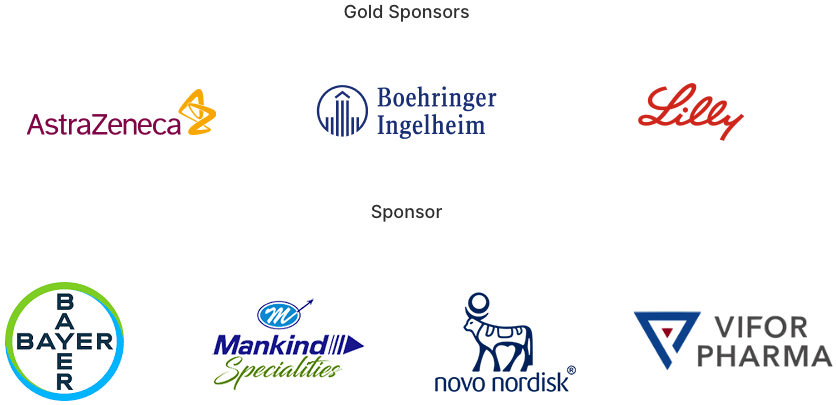
More from this programme
Part 1
Meet the Expert: IgA nephropathy: current optimal management
Part 2
Session 1: The new KDIGO guidelines
Part 3
Industry Session: Iron deficiency in heart failure and kidney disease: interdisciplinary crosstalk
Part 4
Session 2: Recent CV guidelines and treatment algorithms
Part 5
Meet the Experts: NAFLD/NASH as a metabolic disease: improving patients outcomes
Part 6
Session 3: Management of SGLT2 a practical approach
Part 7
Meet the Experts: The meaning of Hemoglobin A1C for the nephrologist and the cardiologist
Part 8
Session 4: GLP-1RA and cardio-metabolic disease in diabetes
Part 9
Industry Session: SGLT2 inhibitors in cardio-renal-metabolic disease: optimizing the patient's journey
Part 10
Session 5: HFpEF: tackling a multidisciplinary problem
Part 11
Meet the Experts: CKD progression in CVD screening and follow-up
Part 12
Meet the Experts: CV, mortality & kidney outcomes with GLP-1 AR in patients with T2DM
Part 13
Session 6: New trial update in cardiology
Part 14
Meet the Experts: The HF Diabetic patient with CKD: optimizing care for a high-risk group
Part 15
Meet the Expert: Multidisciplinary management of cardio-renal-metabolic disease: focus on the kidney
Part 16
Session 8: Sarcopenia, frailty malnutrition and cachexia
Part 17
Meet the Expert: HIF PHI: What do we know and don't know in 2022
Part 18
Session 9: The cardio-kidney interaction: relevance to diabetes
Part 19
Industry Session: SGLT2 inhibition in the comorbid CKD patient
Part 20
Session 10: Why and how to screen for heart failure and kidney disease in diabetes
Part 21
Meet the Expert: SGLT2 inhibitors in heart failure: Improving outcomes across the spectrum of the disease
Part 22
Session 11: SGLT2 inhibition in clinical practice
Part 23
Meet the Expert: The meaning of eGFR for the cardiologists and diabetologist
Part 24
Session 12: Managing obesity in the CRM setting
Part 25
Meet the Experts: Personalized care of patients with heart failure: hyperkalemia as a barrier to optimal medical therapy
Part 26
Meet the Expert: SGLT2, the statin of the 21st century
Part 27
Session 13: New trial update in nephrology
Part 28
Meet the Experts: Reducing the risk of cardiovascular events for patients with CKD and T2DM: new treatment options
Part 29
Session 14: Telemedicine in CRM
Part 30
Session 15: New drugs, new hopes and sometimes risks
Part 31
Meet the Expert: Management of worsening HF
Part 32
Session 16: Harmonising the gluco-and cardio-centric management of diabetes
Faculty Biographies

Sydney Tang
Professor Sydney Tang is currently Chair of Renal Medicine and Yu Professor in Nephrology at the University of Hong Kong. He underwent training in nephrology in Hong Kong and in basic research at King’s College London, UK, and the University of Washington, USA.
Professor Tang’s research interests revolve around pathogenetic mechanisms underlying diabetic and proteinuric kidney disease, and the treatment of immunoglobulin A nephropathy.
Professor Tang is the President-elect of the Asian Pacific Society of Nephrology,an Executive Committee member of Kidney Disease: Improving Global Outcomes, Deputy Chair of the Continuing Medical Education Committee, member of the Saving Young Lives Committee and Education Work Group and an N&E Asia Regional Board member of the International Society of Nephrology, and an International Honorary Member of the Japanese Society of Nephrology. He is a past Chairman of the Hong Kong Society of Nephrology and serves the Hong Kong…






